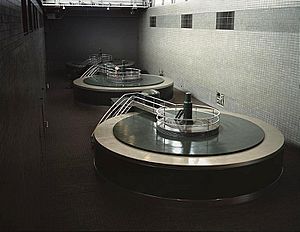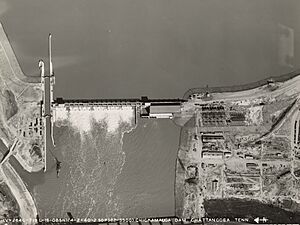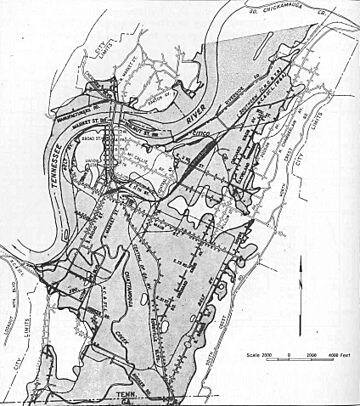Chickamauga Dam facts for kids
Quick facts for kids Chickamauga Dam |
|
|---|---|

Chickamauga Dam
|
|
| Official name | Chickamauga Dam |
| Location | Chattanooga, Tennessee, United States |
| Coordinates | 35°06′14″N 85°13′46″W / 35.10389°N 85.22944°W |
| Construction began | January 13, 1936 |
| Opening date | January 15, 1940 |
| Operator(s) | Tennessee Valley Authority |
| Dam and spillways | |
| Impounds | Tennessee River |
| Height | 129 ft (39 m) |
| Length | 5,800 ft (1,800 m) |
| Reservoir | |
| Creates | Chickamauga Lake |
| Total capacity | 737,300 acre⋅ft (909,400 dam3) |
| Catchment area | 20,790 sq mi (53,800 km2) |
The Chickamauga Dam is a huge hydroelectric dam on the Tennessee River in Chattanooga, Tennessee, United States. A hydroelectric dam uses the power of moving water to create electricity. The Tennessee Valley Authority (TVA) built this dam in the late 1930s.
The TVA built many dams like Chickamauga Dam during a time called the New Deal. Their goal was to help the Tennessee Valley area. They wanted to improve river travel, control floods, and help the economy grow. The dam creates a large body of water called Chickamauga Lake, which covers about 36,240-acre (14,670 ha). This lake then flows into Nickajack Lake. In 2017, the dam was added to the National Register of Historic Places. This means it's an important historical site.
The dam gets its name from the Chickamaugas. They were a group of Cherokee people. Their main village was once located near where the dam stands today. The name "Chickamauga" is also used for local streams and a famous Civil War battle.
Contents
Where is Chickamauga Dam?
Chickamauga Dam is located 471 miles (758 km) upstream from where the Tennessee River ends. It's just east of downtown Chattanooga. The dam is where the Tennessee River meets North Chickamauga Creek.
The lake created by the dam, Chickamauga Lake, stretches for 59 miles (95 km). It goes all the way to the Watts Bar Dam. The lake touches parts of several counties in Tennessee. These include Hamilton, Bradley, McMinn, Rhea, and Meigs counties.
You can drive across the top of Chickamauga Dam. The Wilkes T. Thrasher Bridge carries Tennessee State Route 153 over it. This road connects to major highways like Interstate 75 and U.S. Route 27. The Tennessee Riverwalk, a 10-mile (16 km) walking path, also starts at the dam.
How Big is Chickamauga Dam?
Chickamauga Dam is a type of dam called a concrete gravity dam. It is 5,800 feet (1,800 m) long and 129 feet (39 m) high. This dam can produce 119 megawatts of hydroelectric power. That's enough electricity for many homes!
The dam has 18 spillway bays. These are gates that can open to release water. They can let out a lot of water very quickly, up to 470,000 cubic feet per second (13,000 m3/s).
There is also a special part called a navigation lock. It is 60-by-360-foot (18 by 110 m). This lock helps barges and other boats travel past the dam. It works like a water elevator. It raises or lowers boats 53 feet (16 m) between Chickamauga Lake and Nickajack Lake.
Building the Dam
Before the dam was built, the U.S. Army Corps of Engineers studied the area in the 1920s. They thought it would be a good place for a dam. Chattanooga had suffered from big floods in the past. A dam could help protect the city and improve river travel.
When the Tennessee Valley Authority (TVA) was created in the 1930s, they took over these plans. They decided the best spot was at the tip of Chickamauga Island. Building the dam was approved on December 31, 1935. Construction began soon after, on January 13, 1936.
Building the dam was a huge project. It required buying 61,350 acres (24,830 ha) of land. Many trees had to be cleared. Over 900 families had to move their homes. Twenty-four cemeteries were also relocated. About 81 miles (130 km) of roads had to be moved too.
The navigation lock at Chickamauga Dam was designed by the Army Corps of Engineers. It was similar to a lock at Guntersville Dam. The lock was originally 60 by 360 feet (18 m × 110 m). However, the dam was built so a larger lock could be added later if more river traffic needed it.
Chickamauga Dam was finished on January 15, 1940. The total cost was about $42 million back then. The lock started working on February 26, 1940. The first generator began making electricity on May 4, 1940.
After the dam was built, two parks were created along Chickamauga Lake. These were Booker T. Washington State Park and Harrison Bay State Park.
Dam Upgrades and Repairs
By the early 2000s, the concrete of the original lock was starting to wear out. This was due to a chemical reaction in the concrete. So, a big project began in 2003 to replace the lock. The new lock was planned to be 110-by-660-foot (34 by 201 m).
This project faced some challenges, like not having enough money. The cost grew over time. As of June 2024, the repairs to the lock are expected to be finished by November 2026.
In October 2004, the TVA added a new warning system. This system alerts people downstream when the dam is releasing water. It uses strobe lights, signs, and alarm horns to keep everyone safe.
The TVA also does regular maintenance on the dam. For example, in 2010, engineers worked to repair special joints in the concrete. This helps keep the dam strong and working well.
Fun at the Dam
The Riverpark Area at Chickamauga Dam is a great place for outdoor activities. It has a boat ramp, so you can launch your boat. There are also fishing piers where you can try to catch fish. You'll find areas for day use, restrooms, and shelters you can rent.
The park also has walking and biking trails. These trails are perfect for exploring the area along the Tennessee River. Below the dam, in the shoals, people enjoy fishing for different types of bass, like striped bass, largemouth bass, and smallmouth bass.





